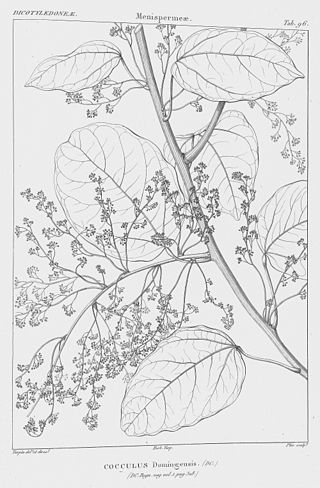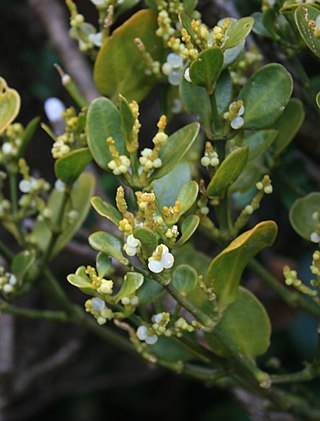
Xylosma is a genus of flowering plants in the family Salicaceae. It contains around 100 species of evergreen shrubs and trees commonly known as brushhollies, xylosmas, or, more ambiguously, "logwoods". The generic name is derived from the Greek words ξύλον (xylon), meaning "wood, tree", and ὀσμή (osmé), meaning "smell", referring to the fragrant wood of some of the species. The Takhtajan system places it in the family Flacourtiaceae, which is considered defunct by the Angiosperm Phylogeny Group.
Leonia is a genus of flowering plants in the family Violaceae. It includes 23 species of small trees or shrubs native to tropical Central and South America, ranging from Guatemala to Bolivia and central Brazil.

Menispermaceae is a family of flowering plants. The alkaloid tubocurarine, a neuromuscular blocker and the active ingredient in the 'tube curare' form of the dart poison curare, is derived from the South American liana Chondrodendron tomentosum. Several other South American genera belonging to the family have been used to prepare the 'pot' and 'calabash' forms of curare. The family contains 78 genera with some 440 species, which are distributed throughout low-lying tropical areas with some species present in temperate and arid regions.

Anomospermum is a genus of flowering plants in the family Menispermaceae. It consists of five species from tropical America, ranging from Nicaragua to southern Brazil.

Odontocarya is a plant genus in the family Menispermaceae. It includes 38 species native to the tropical Americas, ranging from southern Mexico to northern Argentina.
Abuta candicans is a species in the family Menispermaceae.

Arachnothryx is a genus of flowering plants in the family Rubiaceae. It contains about 107 species. It is found from Mexico to Peru and in Trinidad.

Hyperbaena is a genus of plants in family Menispermaceae. It includes 23 species native to the tropical Americas, ranging from Cuba and southern Mexico to northeastern Argentina.

Xylopia is a genus of flowering plants in the family Annonaceae. They are mostly trees and some shrubs. There are about 160 species distributed in Asia, Africa, and the Americas.

Cissampelos is a genus of flowering plants in the family Menispermaceae. Various species of this genus have a history of use in various traditions of herbal medicine. Moreover, many of these plants were used as curare applied as arrow poison during hunting.

Duguetia is a genus of trees and shrubs in the plant family Annonaceae with approximately 90 species in central and South America, and four species in west Africa.
Curarea is a genus of flowering plants in the family Menispermaceae, found in tropical parts of Central and South America. They are dioecious lianas, with at least some species producing toxic compounds such as curare.
Morisonia is a genus of flowering plants in the family Capparaceae, found across the Americas from the United States to Argentina. They are typically shrubs or small trees. The genus was recently enlarged with New World Capparis species due to existing taxonomic instability.

Dendrophthora, the tree destroyers, is a genus of flowering plants in the sandalwood family Santalaceae, native to tropical and subtropical Latin America and the Caribbean. They are hemiparasitic mistletoes that grow on a wide variety of host plants.
Sciadotenia is a genus of flowering plants belonging to the family Menispermaceae.
Elissarrhena is a genus of flowering plants belonging to the family Menispermaceae.










